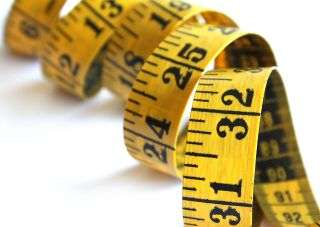
Would you rather use inches or centimeters?
How people measure stuff might seem pretty bland as topics go, but behind America’s insistence to keep drinking coffee in ounces and pumping gas in gallons lies a story with a weighty dose of patriotism, political stability and a historical distrust of the French.
“The paradox is that the way we choose to measure things is banal and boring, but it’s also super important because it structures the way we live and interact with each other,” said Ken Alder, a professor of history at Northwestern University in Illinois, who wrote “The Measure of All Things: The Seven-Year Odyssey and Hidden Error That Transformed the World (Free Press, 2003). “You can’t make comparisons or have an economy without setting standards, and people have bitterly fought for standards because it’s really a fight about how the economy works.”
In the 1790s, the French Academy of Sciences was asked by the government in Paris to come up with a new and logical system of measurement. The academy decided that the new system should be based on something they could physically quantify in nature, so it could stand the test of time. Thus, they decided a meter should be one 10 millionth of a quadrant of the Earth’s circumference — that is, the line running from the North Pole to the equator — a ruling that led to the beginnings of the metric system.
The metric system is arguably an easier way to go about standardizing measurements than the system the United States uses. Everything in the metric system divides into decimals (there are 10 millimeters in a centimeter, 1,000 grams in a kilogram, and so on); most of the rest of the world uses it; and it also just makes sense — for example, water freezes at zero degrees Celsius (as opposed to the random 32 degrees Fahrenheit) and it boils at 100 C (instead of 212 F).
So why hasn’t the U.S. budged an inch? Why do Americans continue to use units of yards, miles and pints? The U.S. customary system has morphed and evolved from a hodgepodge of several systems dating back to medieval England. In 1790, George Washington noted the need for some uniformity in currency and measurements. Money was successfully decimalized, but that’s as far as it got. In truth, the U.S. did try to make the switch a couple times, but it never quite managed to follow through; the British system was too ingrained in American industry as well as the national psyche.
It even took several efforts by various groups in France before the metric system came to be. It wasn’t until the chaos following the 1789 French Revolution that it became possible. “Before then, measures didn’t just differ from country to country, but from town to town,” Alder told Live Science. In fact, it’s thought that prior to the metric system, there were over 250,000 different units of measure in France. Standardizing measures was important to people who traveled. “Local systems screw[ed] over the traders and merchants, whereas the metric system allowed them to know what they were getting. But the locals resisted because they liked what they knew,” Alder said.
It’s worth pointing out that the old measurements worked well for the French locals because these metrics were tied to physical counting systems. For example, a field’s size might be measured by the ‘journée’ (meaning ‘day’ in French), which denoted the number of days it took to harvest its crop. Other times, land was measured in ‘boisseaux’ (or ‘bushels’), to quantify how much grain-seed was needed to sow the land. “The old systems did make sense, they weren’t just totally crazy,” Alder said.
But when the revolution came and Louis XVI succumbed to the guillotine, those who replaced him were part of the Enlightenment movement, during a period known as the Age of Reason, and these new leaders reasoned that Louis’ head should be weighed in kilos. “It was the time for rationalization,” Alder said. “The United States was supposed to be the second country to adopt the new way of measuring things, as the sister republic.”
In 1793, the U.S. Secretary of State, Thomas Jefferson, even sent for a French scientist named Joseph Dombey, who set sail for the New World with a small copper cylinder, which was destined to be America’s new standard weight — a kilogram. But Dombey’s ship was beset by bad weather; an Atlantic wind pushed Dombey’s vessel off course and into the custody of ransom-desiring British pirates. Sadly, he died a prisoner and the kilogram never made it to Jefferson.
But pesky tempests are not the only reason the metric system never caught on stateside; it’s also a question of identity, and not all Americans were as Francophillic as Jefferson, Alder said. “I understand when people resent it as a remote force of globalization that produces uniformity, and it’s perfectly rational to want local control,” he said. “It can also be about taking a position against something that’s hyperrational and French.”
Even in France it wasn’t particularly welcomed. “It literally took 100 years to implement,” Alder noted. The controversy hasn’t ended there. Nowadays, scientists quibble about the fluctuations of the original kilogram and meter, Live Science previously reported.
RELATED MYSTERIES
—What’s the difference between deductive and inductive reasoning?
—Why do Brits and Americans spell words differently?
—Why are marathons 26.2 miles long?
Another factor working against the metric system in the United States is the country’s relative political stability; ever since it gained its independence, elections happened instead of coups and revolutions. That didn’t do the metric system any favors, Alder said, because to completely overhaul a country’s system of measurement requires quite a bit of turmoil for disrupters to take advantage of. “We came close with the Civil War,” he said. “But the conflict wasn’t sufficiently subversive to make that change.”
The United Kingdom for example, only started its journey toward the metric system in the 1970s, after the reality of its geopolitics changed radically; the U.K. not only lost its empire but also began preferentially trading with its continental neighbors over its former colonies, Alder explained. That said, the British have only half-heartedly adopted the new system — road signs are still in miles and pubs still serve beer in pints. (Of note, dry and liquid measurements for pints in the U.K. are not the same as they are in the U.S., according to Encyclopedia Britannica.) Nevertheless, the Jimmy Carter administration tried to follow the Brits around the same time. “[The government] actually tried to put road signs up in kilometers, but people went crazy and it was abandoned,” Alder said.
The U.S. Congress even passed a law in 1975 to make the switch, but unlike the United Kingdom, the transition was deemed to be voluntary instead of mandatory and there was no deadline.
So, for those who long for the U.S. to see sense and ditch ounces for grams — be careful what you wish for, Alder said, because more often than not, the transition is accompanied by more drastic political change.
Originally published on Live Science.
Sourse: www.livescience.com





